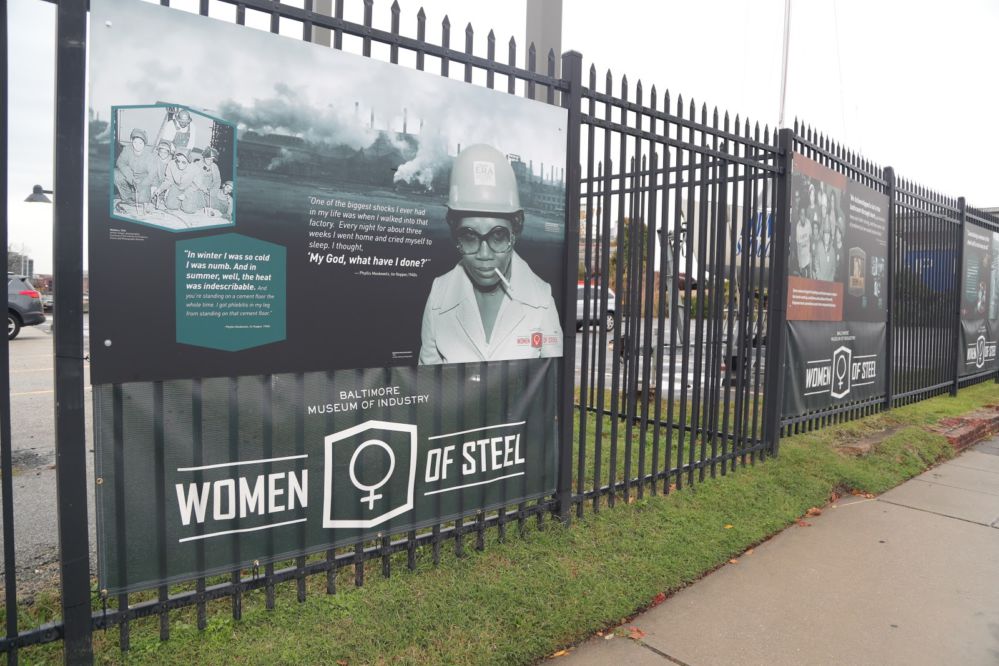
The reimagined exhibition was installed outside, offering visitors a safe, open air experience free of charge.
By Beth Maloney & Claire Mullins
Planning a museum exhibition is always challenging. Planning one with a team of curatorial novices, on a minuscule budget, during a worldwide pandemic is nearly impossible, but it turns out, very rewarding. Women of Steel opened at the Baltimore Museum of Industry (BMI) in mid-October to accolades from our members, donors, the press, and most importantly, many of the women who appear in the exhibition.
As institutions across the nation began announcing exhibitions and programs for 2020 to celebrate the 100th anniversary of the ratification of the 19th Amendment, which gave women the right to vote, the Baltimore Museum of Industry (BMI) contemplated what we could do to mark the milestone. With our Bethlehem Steel Legacy Project—a multi-year initiative to preserve the stories of Baltimore’s steel workers—already underway, we thought a deep dive into the stories of the women who worked at the mill would be particularly powerful.

Members of the exhibition planning team in February 2020.
With no full-time curator on staff, team members from nearly every department in the museum came together to help create this exhibition. Seven BMI staffers started meeting weekly in January 2020 to divide up tasks including reading books on the subject, watching films, getting in touch with local historians, attending steelworkers union meetings, and reaching out to the women themselves, and in some cases, their families.
As we dug into the research, several themes began to emerge: good pay, dangerous work, harassment, fellowship, and childcare struggles. And it also became clear that hearing directly from the women who experienced this work—via oral histories, films, scholarship—was incredibly powerful.
And so, as a group, we decided to offer this exhibition less as a presentation and more as a platform for the voices of women who experienced these issues personally. Rather than writing our own scholarship on women working in the steel industry, we chose to step to the side and highlight the experiences of a few of these women through existing oral history projects. We used social media, word of mouth, and online searches to track down photos of women at work at Bethlehem Steel. Our team began to hit its stride.

Exhibition designer Danielle Nekimken’s rendition of the Women of Steel exhibition inside the Baltimore Museum of Industry
Then COVID-19 hit.
Suddenly planning an exhibition became an exercise in public health. How could visitors maintain their social distance in a gallery that measures sixteen by sixteen feet? Seating and hands-on activities—two elements that we know visitors love— were eliminated. Even if we could somehow get this all pulled together, would anyone be ready to visit a museum in the midst of a pandemic?
One benefit of planning in a purposefully democratic environment is that everyone had a voice, and at some point during our weekly Zoom meetings it was suggested that we change course and do something we’d never done before: take the museum outside of our walls, literally. We’d seen some examples of other museums on social media thinking about this possibility and, given our own campus and the exhibition elements we’d gathered, a plan was hatched.
Working closely with our brilliant graphic designer, Danielle Nekimken, we reimagined this exhibition to fit a stretch of fence along our campus. Here we imagined that visitors, neighbors, and community members could learn about the women steelworkers who sacrificed and toiled alongside men—doing the same work for less pay—in a safe open-air environment. The pandemic also provided an opportunity to tie the risk and rewards equation faced by the steelworkers to today, where two-thirds of “essential workers” are women, many of them of color.
We opted not to charge admission, but education and serving our community are key values for us as an organization, especially during this time. And we also wanted to make sure we fulfilled our mission to connect stories of the past with the contemporary experience of workers. This project was truly an embodiment of both our values and mission – and in an accessible, informative and engaging way.
For most of us on the planning team, it was the first time we’d created something of this magnitude. Engaging in a more democratic exhibition development process has informed and continues to inform the way we’re working as a team. Indeed, this democratized planning process was presented as a session by one of our team members during the 2020 AASLH conference as the exhibition was being installed.

Former crane operator Addie Smith (left) stands in front of an exhibition panel featuring her story. Photo courtesy of Deborah Cardin.
We’re so proud of this exhibition. It provided not only a look into the life of the women of Beth Steel, but an opportunity to engage with our colleagues in a collaborative and creative way. It was a true labor of love.
Beth Maloney is the Baltimore Museum of Industry’s Director of Interpretation and Claire Mullins is the Director of Marketing and Events. Both were part of the Women of Steel exhibition team.
The Women of Steel exhibition was made possible through gifts from Tradepoint Atlantic, PNC Bank, Robert Patterson, the Macht Fund of the Associated, and the Alvin and Louise Myerberg Family Foundation.



